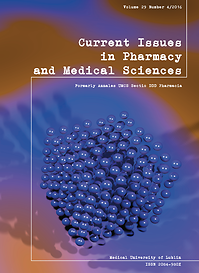Oxidative metabolism of neutrophils in patients with community-acquired pneumonia
DOI:
https://doi.org/10.1515/cipms-2016-0001Keywords:
neutrophils, oxidative modified proteins, community-acquired pneumoniaAbstract
At the present time, available views show our limited knowledge of the peculiarities of the functional status of neutrophils and their metabolism in patients with communityacquired pneumonia (CAP). The studying of changes of metabolic status of neutrophils can broaden our views about pneumonia pathogenesis and define datum points of therapeutic effect.
Purpose of our research: to define oxidative stress activity and the level of oxidative modification of proteins of neutrophils in CAP patients.
Materials and methods: neutrophils obtained from 23 patients with communityacquired pneumonia. Control group consisting of 19 healthy volunteers. The reactive carbonyl derivatives of proteins and advanced oxidation protein products were defined so as to assess the oxidative damage of proteins. The malondialdehyde and nitrite ions were assessed as being indicators of the oxidative stress. The neutrophils of CAP patients with moderate severity were characterized by a tendency of evidencing decreasing content of advanced oxidation protein products, along with the statistically important enhanced levels of carbonyl derivatives and nitrite ions, while their malondialdehyde status practically leveled off with the control and had only an insignificant trend towards growth. We have demonstrated the accumulation of carbonyl derivatives and nitrite ions in the peripheral neutrophils of CAP patients. These results give evidence of an oxidative misbalance in the cells which contributes to the aggravation of the disease.
References
1. Bordon J. et al.: Understanding the roles of cytokines and neutrophil activity and neutrophil apoptosis in the protective versus deleterious inflammatory response in pneumonia. Int. J. Infect. Dis., 17, 2, 2013.
2. Cape J. L., Hurst J. K.: The role of nitrite ion in phagocyte function—perspectives and puzzles. Arch. Biochem. Biophys., 484, 2, 2009.
3. Fedorova M.Z.. Levin V.N.: The method of complex study of geometry. surface area. the reserve capacity of the membrane and maintain the body’s white blood cells. Clin. Medicine., 8, 2000, (Article in Russian)
4. Goncharenko M.S., Latinova A.M.: Method of assessment of peroxide oxidation of lipids. Lab. case., 1, 1985, (Article in Russian)
5. Levine R.L. et al.: Determination of carbonyl content in oxidative modified proteins. Method. Enzymol., 186, 1990.
6. Premanand R., Kumar S., Mohan A.: Study of thiobarbituric reactive substances and total reduced glutathione as indices of oxidative stress in chronic smokers with and without chronic obstructive pulmonary disease. Indian J. Chest Dis. Allied Sci., 49, 2007.
7. Ridnour L. A. et al.: A Spectrophotometric method for the direct detection and quantitation of nitric oxide. nitrite. and nitrate in cell culture media. Analytical Biochemistry, 281, 2000.
8. Segel G. B. et al.: The paradox of the neutrophil’s role in tissue injury. Journal of Leukocyte Biology, 89, 3, 2011.
9. Tomczykowska M. et al.: Oxidative metabolism of neutrophils in patients with initial “outside-hospital” pneumonia. Ann. Univ. Mariae Curie Sklodowska Med., 58, 1, 2003.
10. Witko-Sarsat V. et al.: Advanced oxidation protein products as a novel marker of oxidative stress in uremia. Kidney Int., 49. 1996.
11. Yang D. et al.: Pro-inflammatory cytokines increase reactive oxygen species through mitochondria and NADPH oxidase in cultured RPE cells. Exp. Eye Res., 85, 4, 2007.
12. Zhavoronok Т.V. et al.: Influence of oxidative stress on redox-state and peripheral blood heterophilic leukocytes apoptotic program realization. European journal of natural history, 6, 2007.
13. Zhou X.et al.: Neutrophils in acute lung injury. Front Biosci. 17, 2012.
14. Zimmermann B. et al.: Impaired neutrophil exocytosis in patients with severe pneumonia. Intensive Care Med., 25, 1, 1999.
Downloads
Published
Issue
Section
License
Copyright (c) 2016 Authors

This work is licensed under a Creative Commons Attribution-NonCommercial-NoDerivatives 3.0 Unported License.


